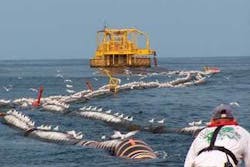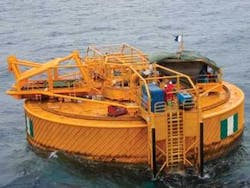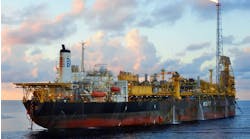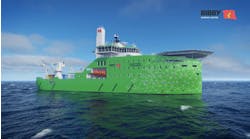Michael Quinnell
Environmental conditions can severely impact operations involving Single Point Mooring (SPM) buoys. Operational requirements for SPM tanker loading maneuvers are complex. The dominant meteorological and oceanographic (metocean) forces acting on the vessel are liable to change from wind-induced to surface current as vessel draft increases.
The need is growing to monitor metocean conditions in such situations, as well as the resulting tensions on the anchor chain and tanker mooring hawsers at the SPM loading buoys. The data can be used to support tanker operations, minimize the risk of incidents, and provide site-specific reports to aid future design.
Djeno was Fugro GEOS’ first application of its metocean instrumentation package off West Africa.
The use of SPM buoys, often referred to as Catenary Anchor Leg Mooring (CALM) buoys, is commonplace for offshore loading operations. Under the standard berthing procedure, the tanker approaches the SPM into the dominant force (wind or current), moors to the SPM, and picks up the floating hoses to begin loading. A tug then pulls the tanker from the stern to ensure it does not ride over the SPM in the event of a sudden change in external forces (e.g. wind or current).
When the tanker first moors to the SPM, it is empty or partially filled (depending on the cargo parcel size), and its draft is at a minimum. Wind force generally dominantes current force, and dictates the angle at which the tanker lies to the SPM. As the tanker takes on oil, its draft increases, and the reduction in topsides height can make current the dominant force.
The force vectors of wind and current often differ in magnitude and direction, which also can alter the tanker’s position relative to the SPM. Personnel on the tug may not notice this change, however, because the SPM is hidden from view below the tanker’s stern. Onboard the tanker, the SPM may not be visible from the bridge because it lies under the tanker’s bow. If the tanker moves, there is a danger of forward impact with the SPM, with potential damage preventing offloading pending SPM repaired.
Offshore West Africa, near-surface currents can be strong and variable in time and location. Additionally, squalls are frequent, and can impose strong and variable forces upon a tanker moored to an SPM. However, if the tanker pilot can accurately assess the strength and directions of these forces during approach and connection to the SPM, and also can monitor changes, the risk of impact with the SPM can be minimized.
Djeno/Bonga solutions
The first real-time monitoring system Fugro GEOS supplied to a West African SPM was for the 12-m diameter buoy on Total’s Djeno field offshore Congo. It was fully installed in early 2004. More recently, this type of system was installed on the Bonga field’s “Stella”, the largest SPM in the world. Another system was commissioned for another SPM offshore Nigeria.
The Bonga SPM buoy.
Both installations are designed to support tanker approach, berthing, and offloading operations from the SPM and FPSO. Additionally on the Stella, the existing hawser and anchor tension system was upgraded and integrated into the metocean system to transmit real-time metocean, hawser, and anchor tension data to fixed displays on the Bonga FPSO and to portable displays on the tanker and tug. It was commissioned in May 2005.
The primary objective is to have accurate and integrated metocean and tension data in real-time displayed on the two vessels in support of tanker approach, mooring, and disconnection operations. Also important is the ability to monitor prevailing metocean and mooring hawser conditions relative to wave height, wind speed, current speed and hawser tension operating limits for offloading. Logged data is archived to assist design analysis of FPSO and SPM moorings and risers for the life of the field and for future field developments.
A full panoply of metocean instrumentation is available on the Djeno and Bonga systems, including sensors to measure near-surface and deep profiles of currents; wave height and period; a variety of meteorological parameters; SPM motion and accelerations; and SPM anchor tensions and tanker mooring hawser tensions.
The monitoring systems are configured to provide high-quality, high-accuracy data for real-time distribution to operations personnel, and for subsequent operational efficiency assessments. A key feature is the use of solid-state sensors to reduce maintenance requirements, while complying with stringent hazardous zone regulations.





